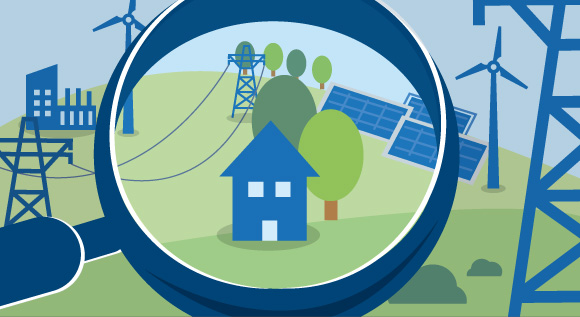What exactly is blockchain?
Blockchain has become widely known as the technology underlying the virtual currency Bitcoin. Now it is also being put to use in the energy sector. But what exactly is blockchain? And how can blockchain technology help us transition to a sustainable supply of energy? The answers can be found below.
 © BMWi
© BMWi
This is what it’s all about: Using decentralised networks to carry out digital transactions directly and in a secure manner.
Wind turbines in the fields outside of town, solar panels on the roofs all over the district, a mini power station in your neighbour’s basement. The energy transition means that more of our electricity is generated in decentralised networks. It is increasingly being generated in small-scale generation facilities rather than in large-scale power plants. And consumers not only consume electricity, they now also often produce it – a phenomenon which has given rise to the term ‘prosumer‘.
This new world, in which more of our electricity is generated in decentralised networks, has a lot in common with blockchain, which is also a decentralised technology. For example, blockchain technology can be used to transfer electricity from your neighbour’s mini power plant to your own home without having to use a utility as an intermediary.
It all started with Bitcoin
Blockchain technology was originally developed for the virtual currency Bitcoin, which enables online payments to be transferred securely and directly, without using a bank as an intermediary. Payments are transferred directly from buyer to seller.
In order to make sure that the payment is transferred in a secure manner, a decentralised network is used – a network that users can trust. Data about who sends and receives the payment, and about the amount that is transferred, are stored not only on the computers of the buyer and seller, but in addition to that in a decentralised database. This database is composed of a network of an indefinite number of computers of other users. The transaction data is encrypted, meaning that nobody can see any details of the transaction except the two parties involved. After the transaction has been completed, blocks of information are stored across the whole network of computers. Each new block of information is linked to the preceding block of information, adopting information from this block. This leads to the development of a chain of blocks in which each block is inextricably linked to all of the older blocks, and in which all computers constantly monitor whether the individual blocks of the chain fit together. If someone wanted to hack the data used in a particular transaction – i.e. in a particular block – this person would have to manipulate the whole chain of blocks across the entire network of computers – something which would take a huge amount of time and resources. This is why blockchain technology is considered to be extremely secure.
Pilot projects in the US...
At present, blockchains are mainly used in payment transactions in bitcoins. But there are also many ways in which they can be used in the energy sector, such as to pass on distributed energy directly and decentrally. The first pilot projects are already under way, with the Brooklyn Microgrid project one of the most well known. In April 2016, ten houses were all connected up to a distributed electricity grid. Five of them have a solar panel on the roof, and five don’t. The electricity that the houses fitted with solar panels do not use themselves is sold to the other five houses. Using smart meter technology, which measures the flow of current, and smart contracts, with which the contractual agreements can be delivered independently, blockchain enables electricity transactions and the charge payable to be made securely and in a direct manner between the households concerned.
...and in Germany
Blockchain is also being tested in the energy sector in Germany by companies such as transmission system operator TenneT and battery storage firm Sonnen. By the middle of this year, up to 6,000 home storage units for photovoltaic energy are to be connected in order to provide greater flexibility in the electricity grid. If, for example, wind and solar installations produce more electricity than is needed at a given point, this electricity can be transferred to a home storage network, to be used later. When there is little wind or sunshine, the electricity that has been stored can be released back into the electricity grid and be drawn by consumers. The storage units are networked together using blockchain, which enables an exact overview of which unit has received additional electricity and has released it back into the grid again, and how much electricity this was. This is particularly important for billing as those part of the network can use the additional electricity at no charge. In contrast to the Brooklyn Microgrid, this pilot project is not only about the exchange of electricity between prosumers, but also about stabilising the electricity grid.
High potential but many challenges
It remains to be seen whether blockchain applications will also be able to support the energy transition on a large scale, beyond the pilot projects. The experience gathered to date has at least shown much promise. If this does become possible on a broader scale, blockchains could make electricity supply and demand more flexible and thus help to strengthen security of supply and grid stability. This would then open up the possibility of creating a fully digitised, self-managing electricity market in which energy is always produced and fed into the grid exactly where it is needed. Before this can happen, however, there are not only many technical issues that need to be resolved, but also many legal and regulatory ones, such as what rules would apply between the different prosumers and who would be able to bill whom for what. Answers to these questions will need to be found over the next few years.

